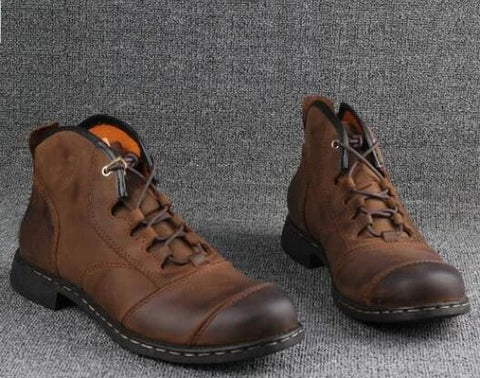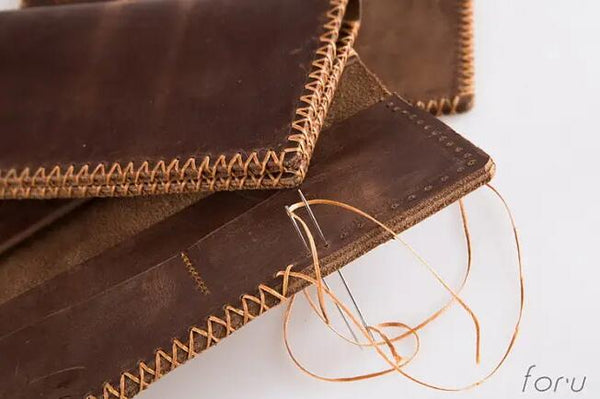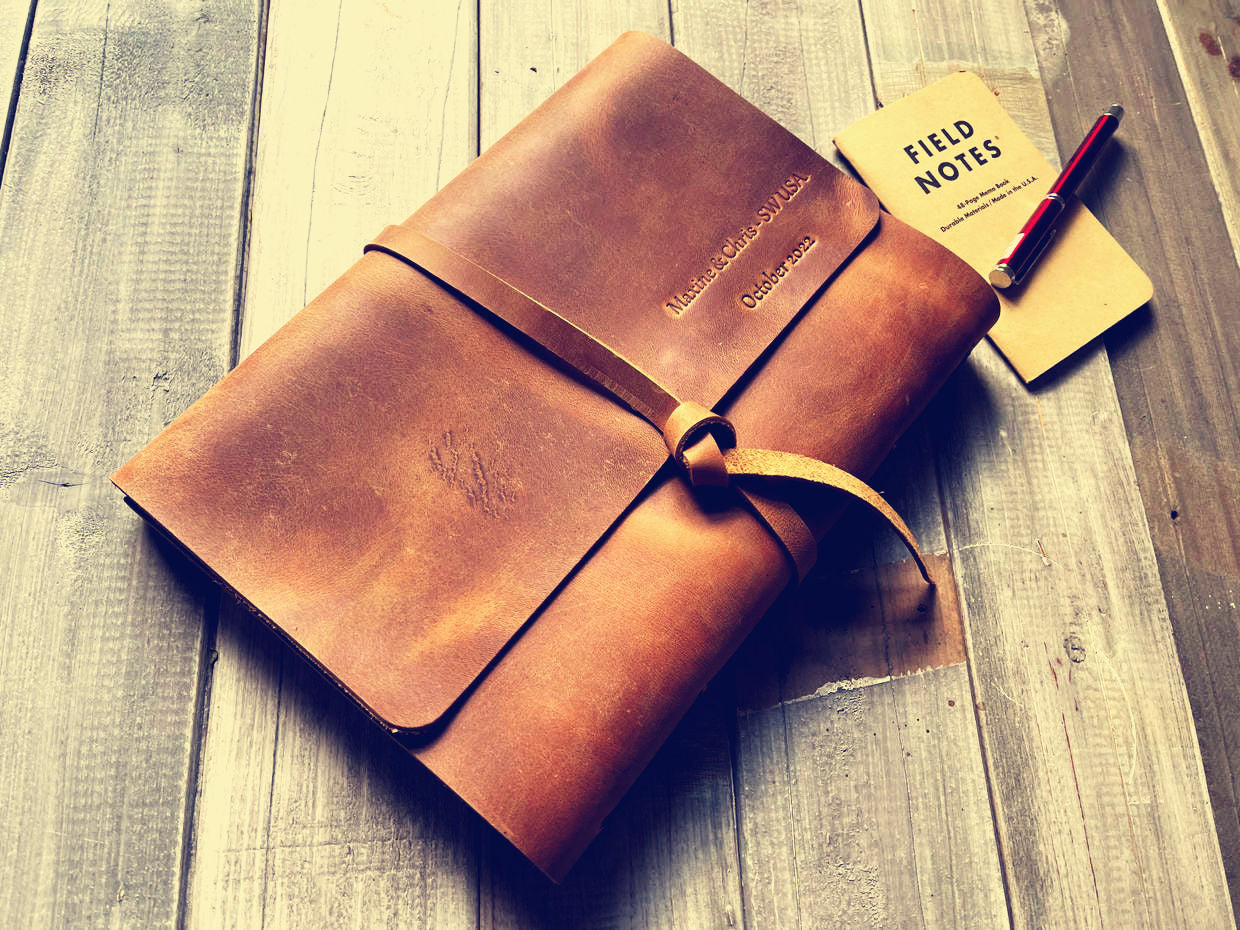Your cart is currently empty
How To Age Leather: The Traditional Way
Leather is attractive, as we all know. Likewise, as it ages, its beauty only improves. But why does leather get more attractive with time? And how exactly does leather deteriorate? You will learn what makes leather gorgeous in this post. Additionally, we'll demonstrate the two methods for aging leather.
What Is Patina: A Basic Guide
Why is leather so gorgeous? Leather patina is the solution. Although this post focuses on how to age leather, we will only briefly discuss leather patina in this section. You can visit our leather patina guide to learn more about it.
Let's take a quick look at the leather patina. In essence, the patina is the result of leather's aging process. It is the gradual alteration that occurs at the surface of the leather. However, only real premium leather, such as top-grain and full-grain leather, can see it. Similarly, some people view the leather's beautiful patina as a sign that they are the owner of high-quality leather due to its attractiveness. As a result, leather is desired not just for its sturdiness and hardness but also for the old look it imparts. On how to make leather look old, discussing leather patina is crucial. This is due to the fact that leather aging essentially results in a leather patina. There are many ways to get there, even though there is only one outcome. Let's learn more about these techniques.

How can fresh leather be made to appear worn-in?
- The Conventional Method
Basically, aging leather the old-fashioned way is incredibly easy but also very laborious. It is easy because there is not much work involved. However, it is difficult since you have to wait so long for the leather to age and provide the desired results.
Is it really so easy?
Yes, it really is that easy. Simply put, you must use the leather in the same manner that you normally would. This is because the leather will be exposed to various factors if it is used frequently. These substances will aid in the leather's disintegration. The change will result in giving the leather a vintage appearance. For instance, using a leather bag frequently will subject it to various factors, such as sunshine. Natural oils further aid the natural aging of the leather.
However, exposing leather to various elements will probably result in various patina effects. For instance, leather that is frequently exposed to heat or sunlight will alter differently than leather that is frequently exposed to rain. The leather will probably turn golden as it ages from exposure to sunlight. On the other hand, splash marks from rain or seawater are likely to be visible on the surface of the leather. Meanwhile, the black patches in the leather are probably caused by natural oils in the leather. But occasionally, these areas are simply the result of unkempt stains.
You need to have patients
The old method is difficult because it takes a lot of time. As a result, aging's effects require a lot of patience. However, it is something that is worth the wait. Additionally, caring for and cleaning leather is crucial during the aging process. This is due to the fact that leather, like any biological substance, can degrade with time. To observe the effects, it is crucial to take care of them. Conditioning leather is more crucial than anything else. Your leather will benefit from conditioning if you want to maintain its fibers strong and flexible.
You will need to clean and preserve your leather sometimes if you age leather the traditional way. All of that work, though, will eventually be worthwhile.

How to age leather
- Distressing Leather
There are certain individuals, though, who are not the kind to wait around while the leather ages. There is a shortcut available for those who don't want to wait. Distress leather using this technique. This changes the leather's surface, giving it a worn-in, vintage appearance.
Please remember this:
The leather is not destroyed throughout this process; rather is distressed. By mistreating the leather, we are attempting to alter its appearance but in no way are we attempting to damage it. So be careful when distressing leather!
Additionally, top-grain and full-grain leather are the only types of high-grade leather that can be used in this method. Genuine leather, which is of lower quality, may likely be harmed if it is distressed. The same is true for imitation leather and PU leather.

Distressing Leather: A Guide
You'll need the following items to distress leather:
- Alcohol by-products, preferably 90% rubbing alcohol
- A spray container
- Nitrile gloves
- Leather Conditioner Fine-Grained Sandpaper
- A brush with thick bristles Dry Dirt (optional)
- Alcohol to Wet the Leather
So the leather must first be treated with alcohol. To apply the alcohol, use a brush or a towel. Nevertheless, we favor using a spray bottle. Alcohol should only be used to spray leather very gently. We are merely trying to dampen it; don't drown it in a drink. This will assist the leather in becoming drier and taking on a worn appearance.
Massage the leather roughly.
Give the leather a massage while it is still damp from the alcohol. If necessary, crease it, crumple it, knead it, and beat it. The leather will get some surface lines and creases as a result.
- Rub The Leather With Sandpaper
After that, sand the leather. Use just fine-grit sandpaper, please! Rub the sandpaper in the places where it would seem most battered or disturbed. For leather bags, you might concentrate on the corner and the bottom of the bag. It's crucial to stop sanding sometimes and assess your progress. Be careful not to sand the leather too much. After sanding the leather, you can also condition it with a leather conditioner.
- Use a sturdy bristle brush to clean the leather.
Give your leather a short brush if you want it to look more worn. Use the brush, similar to how you sanded the leather in the previous step.
- Dust the leather a little bit
Throw some dust on your leather to give it a dusty appearance. To add some flair, you can throw some sand, mud, or even dust. Once you are happy with the appearance, brush off any extra sand, mud, or dust.
Distressing leather
- Use rubber olive oil
Spray some rubbing alcohol over the leather using a spray bottle. You may also use a cloth or even a toothbrush to apply it. Don't soak your bag in rubbing alcohol; you only want to dampen it. This will cause the leather to dry out and start to take on a weathered appearance.
- Get it beat
Crumple, fold, and knead the leather while it's still wet from the rubbing alcohol. Here's how to give the leather a worn-in appearance with wrinkles and folds on the surface.
- Break out the sandpaper
To make the leather appear more worn, lightly sand it. Focus on the areas of your luggage that would ordinarily receive the most wear and tear, such as the bottom and corners. This is also an excellent time to pause, assess your work, and think about using leather conditioners to pamper the leather.
- Find a heavy brush with bristles.
Use a wire brush or a heavy-bristled brush on your leather to damage it further. Apply the brush in the same manner as you did the sandpaper, paying particular attention to areas that naturally show wear.
- Push a little dust
Finally, take your bag outside and bury it in the dirt to give it a dusty, weathered appearance. I mean dry dirt. You're not attempting to make it muddy. However, if you like, you can kick it around in some mud, dust, or even a sandbox. Simply brush off the excess once you've achieved the desired look and texture.

How long does leather take to age?
Patina symptoms could appear in as little as a week, a month, or even a year. The slow transformation is only apparent when comparing "before and after" photos. Although patience is a virtue, regular use is one surefire way to speed up the process.
The patina on leather is frequently mistaken for filth or grime, although it is actually a natural by-product of the leather age. Lower-quality materials lack patina; only genuine leather products exhibit it.
The leather that acquires the nicest patina is the best leather. Your skin's natural oils, the conditioner in your hair products, and even the lotion on your hands all help your leather goods develop a distinctive patina.
This impact can take years of consistent use to become apparent, but once it does, you'll know it's something truly exceptional. After all, leather is among the toughest materials that have ever been created by humans.
Leather that has "aged" or "tanned" from use is referred to as patina leather. There are several ways to accomplish this, including exposing yourself to the elements.
The Latin word patina, which means "coating," describes exactly what this process accomplishes to leather: it gives it a glossy, shining sheen that will act as a barrier against spills and scratches. And even though you might be accustomed to "breaking in" your favorite leather shoes, the process should go considerably more quickly with patina leather due to its tough design.
How does patina develop on leather?
The appearance of worn leather appeals to many people. When you first buy, leather items are glossy and coated with a protective chemical. This substance gradually wears away, exposing color undertones and defining texture. Patina development is the process involved in this. It's comparable to how wood ages to take on a deep color or how metal develops rust stains.
In reality, patina is the natural process by which leather develops a protective coating in response to exposure to acid and water. Many people mistakenly believe that patina refers to an aesthetic state of decay and neglect.
Beginning the process is the introduction of dirt, salt, and other things that penetrate the leather's fibers. These acidic substances interact with the lignin in the fibers to produce melanin, a soft brown pigment.
What effect does the patina have on leather quality?
When the leather's surface starts to age and deteriorate, revealing its natural character, the patina process starts naturally. Your leather will have more personality the more patina it has. Even though patina can sometimes negatively impact leather, you should be aware that it won't always do so.
While the majority of people think that leather's finish won't hinder its longevity if it is cared for properly, some contend that patina must be removed from leather for it to last over time.
What kind of leather creates the best patina?
Numerous new products, hues, and finishes have emerged due to the leather business. Vegetable-tanned leather is one of the most popular types of leather.
Natural tannins from plants, fruits, leaves, bark, roots, and other trees are used to produce vegetable-tanned leather, which is non-toxic to humans and animals. Vegetable tanning is thought to produce the nicest patina because no artificial chemicals are employed in the process.
How to accelerate the process of patina development?
It can take a while for leather, or any other material for that matter, to develop a patina. The fact that there are so many variables in the equation doesn't help. Does the leather in use have animal skin in it? Which species did it belong to? What modifications have been made since it was tanned? Has it been dyed? Painted? Waxed? Degreased? To get a patina going quickly, there are simply too many different factors. Utilizing a blend of natural compounds and acids may help to hasten the development of the leather patina. One part vinegar, four parts water, one teaspoon salt, and one tablespoon lemon juice are shown to function effectively together.
The mixture should be applied to the leather using a sponge or soft cloth. Allow the mixture to remain on the leather for 20 minutes after application, then wipe it off with a fresh cloth.
How may the patina process be slowed down?
Many people are aware that leather deterioration is a natural process, but many do not know how to stop it. You can accomplish this by taking the following easy steps:
- Frequently apply conditioner and moisturizer while wearing the garment. It will lubricate the leather from the inside to maintain it healthy and supple and to delay aging.
- According to studies, sealing leather with beeswax will slow the leather's patina process. Natural components in beeswax are beneficial for waterproofing and preserving leather. It may also emit a pleasing scent.
Does patina work?
Leather is regarded by many as one of the strongest and most adaptable fabrics. It goes without saying that if an animal is to withstand the butchering process, its hide must be strong. Some individuals prefer patina leather's natural, damaged aspect because it makes the material appear used rather than brand new. But is leather with patina good?
Using patina leather is a cheap technique to get an aged antique look. Customers love this sort of leather because it requires less maintenance than other varieties of leather. The texture of patina leather can be produced chemically or naturally, such as by exposure to sunshine. It is sturdy and long-lasting, making it ideal for items like bags, furniture, and apparel.
How is patina removed from leather?
It might be challenging to remove the patina from the leather. Patina is a thin layer of discoloration that develops over time on the exterior of leather due to exposure to the weather. There are a few techniques for removing patina from leather, but the majority of them call for vigorous chemical cleaning. Rub in a paste composed of baking soda and water to remove the patina off smooth leather using this approach.
Conclusion
On leather goods, patina is a natural phenomenon. It comes about as a result of leather proteins interacting with environmental acids to provide a protective finish. Depending on the user's usage and the kind of leather employed, the patina will change. Natural materials like leather have the capacity to change with time. It gets silkier, supplier, and appears noticeably richer in color as it ages. The hue of the leather as it ages and changes is simply known as the patina on leather. Because the patina demonstrates use-related wear and tear, it enhances the beauty and individuality of vintage and handmade items. In this article, we have shared some information about aging leather. If you are interested in leather, then this article is for you.
Shop our collection of:
Leather Embossed Journals | Refillable Leather Journals | Leather Sketchbook | Customized Leather Portfolios | Leather Refillable Planner | Leather Bags For Men | Leather Bags For Women
Related Blog Posts:




